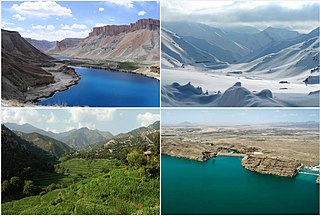
Transport in Afghanistan is done mostly by road, rail and air. Much of the nation's road network was built in the mid-20th century but left to ruin during the last two decades of that century due to war and political turmoil. Officials of the current Islamic Emirate have continued to improve the national highways, roads, and bridges. In 2008, there were about 700,000 vehicles registered in Kabul. At least 1,314 traffic collisions were reported in 2022.
The Kabul–Kandahar Highway (NH0101) is 483-kilometer (300 mi) long that links Afghanistan's two largest cities, Kabul and Kandahar. It starts from Dashte Barchi in Kabul and passes through Maidan Shar, Saydabad, Ghazni, and Qalat until it reaches Aino Mina in Kandahar. It is currently being rehabilitated at different locations. This highway is a key portion of Afghanistan's national highway system or "National Highway 1". The entire highway between Kabul and Kandahar has no mountain passes but there are many mountains nearby in some places. Approximately 35 percent of Afghanistan's population lives within 50 km (31 mi) of the Kabul to Kandahar portion of the Afghanistan Ring Road.

The Taliban insurgency began after the group's fall from power during the 2001 War in Afghanistan. The Taliban forces fought against the Afghan government, led by President Hamid Karzai, and later by President Ashraf Ghani, and against a US-led coalition of forces that has included all members of NATO; the 2021 Taliban offensive resulted in the collapse of the government of Ashraf Ghani. The private sector in Pakistan extends financial aid to the Taliban, contributing to their financial sustenance.
Muqur is a district in the southwest of Ghazni province, Afghanistan. Its population was estimated at 70,900 in 2002, of whom 19,538 were children under 12.

Qarabagh or Qara Bagh, is a district in Ghazni province, 56 km to the south-west of Ghazni city in eastern Afghanistan. The 1,800 km2 area is one of the most populated at 109,000; some reports count more than 218,000. The ethnic composition of the district includes Hazaras and Pashtuns. The landscape varies in different parts of the district - deserts in the southwest, plains in the southeast and mountains in the north. The district is seriously affected by drought, especially farming and animal husbandry. Health and education need serious improvement.
The following lists events that happened during 2004 in Afghanistan.

Tourism in Afghanistan is regulated by the Ministry of Information and Culture. There are at least 350 tourism companies operating in Afghanistan. Tourism was at its peak before the 1978 Saur Revolution, which was followed by the decades of warfare. Between 2013 and 2016, Afghan embassies issued between 15,000 and 20,000 tourist visas annually.
The following lists events from 2014 in Afghanistan.
The following lists events that happened in 2013 in Afghanistan.
The following lists events that happened during 2015 in Afghanistan.
The following lists events that happened during 2016 in Afghanistan.

On 31 May 2016, the Taliban set up a fake military checkpoint along the Kunduz–Takhar Highway, near Arzaq Angor Bagh in the Kunduz Province of Afghanistan, and deployed approximately 250 militants there after disguising them as Afghan government officials. They subsequently kidnapped between 220 and 260 civilians coming through the checkpoint and held them as hostages, prompting the assembly of a rescue effort by the Afghan Armed Forces. By 8 June, at least 12 abductees were executed and more Taliban attacks followed throughout other parts of the country. A total of 33 people were killed in the ensuing hostage crisis. The exact death toll is unknown, but it is believed that most of the hostages were released or rescued.

On 3 September 2016, at least 38 people were killed and 28 were injured after a fuel tanker carrying two people collided with a passenger bus carrying over 60 people on the dangerous Kabul-Kandahar highway in the province of Zabul, Afghanistan. The accident comes after an even larger incident that occurred on the same highway in May.
Events in the year 2017 in Afghanistan.
In May 2020, a series of insurgent attacks took place in Afghanistan, starting when the Taliban killed 20 Afghan soldiers and wounded 29 others in Zari, Balkh and Grishk, Helmand on 1 and 3 May, respectively. On 12 May, a hospital's maternity ward in Kabul and a funeral in Kuz Kunar (Khewa), Nangarhar were attacked, resulting in the deaths of 56 people and injuries of 148 others, including newborn babies, mothers, nurses, and mourners. ISIL–KP claimed responsibility for the funeral bombing, but no insurgent group claimed responsibility for the hospital shooting.
In a continuation of previous attacks by the Taliban in May and June, multiple clashes between Afghan security forces and the Taliban were reported. They carried out several attacks throughout Afghanistan, resulting in multiple fatalities on both sides. Both the Taliban and government forces have accused each other responsibility over the recent surge in violence across Afghanistan. The attacks come despite the signing of a peace deal with the U.S. in February that was intended to put an end to the war.
Events in the year 2024 in Afghanistan.






